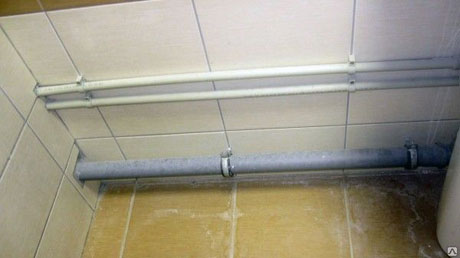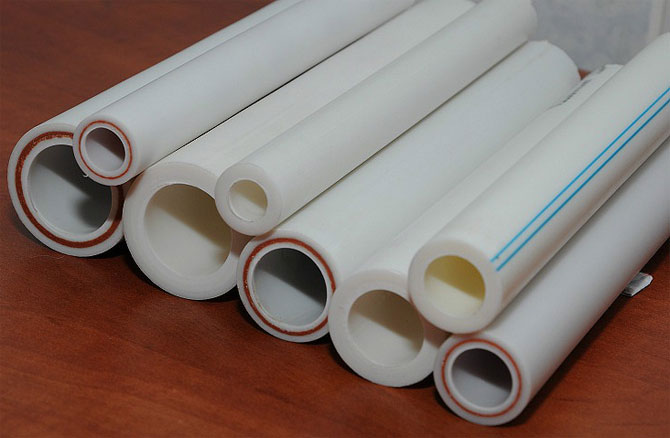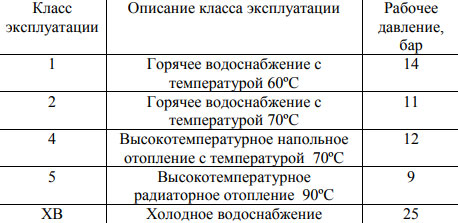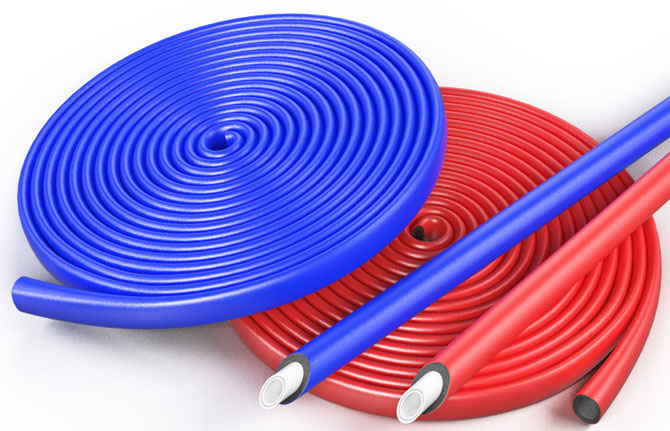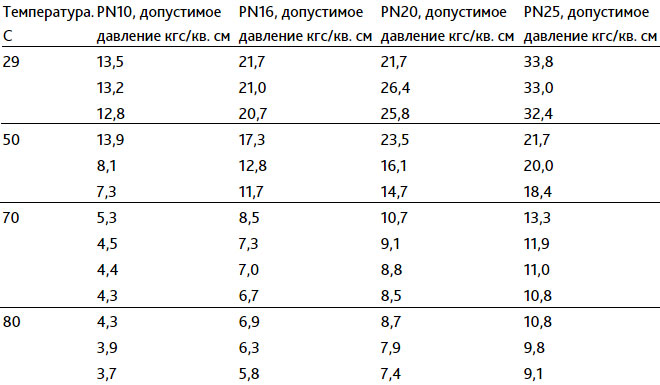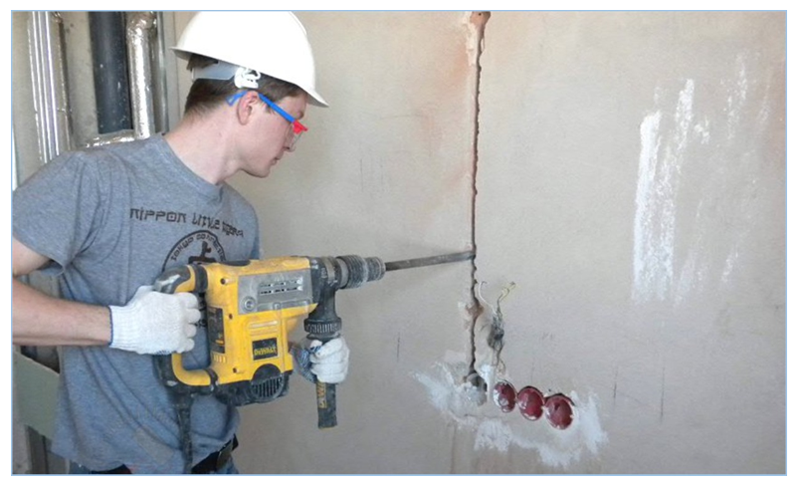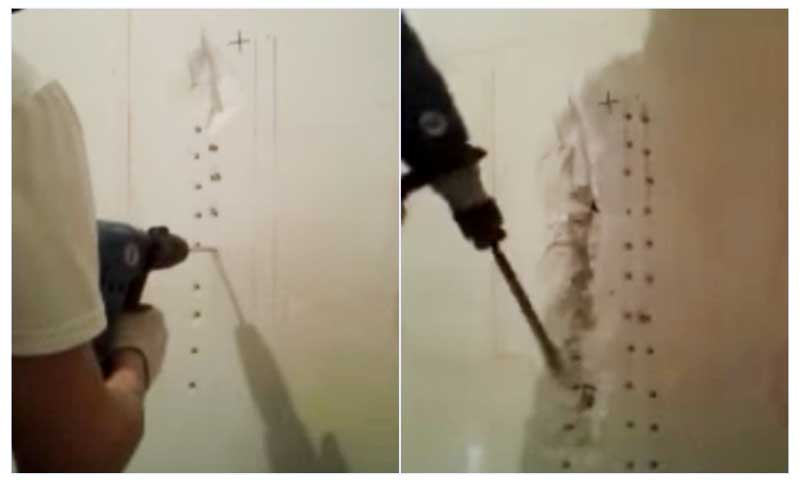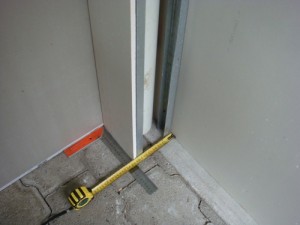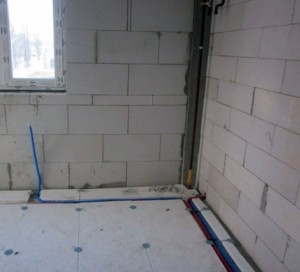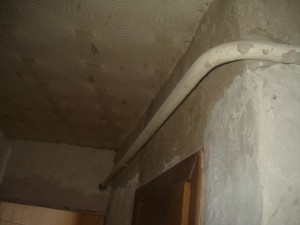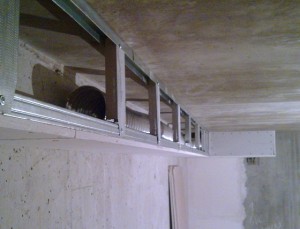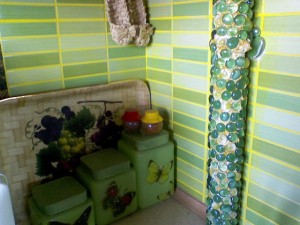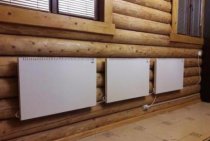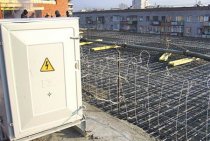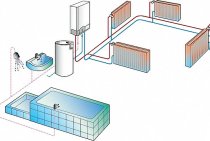Features of polymer pipes
Heating substances increases their volume, says a school physics course. This applies to plastics in full, since the temperature also makes them plastic. If, when laying a pipeline for cold environments, the expansion coefficient can be practically ignored, then when installing a heating system, this aspect must always be kept in mind.
It is this fact that raises doubts about whether it is possible to wall up polypropylene pipes into the wall, which, when hot water is started, will both expand and lengthen. Will such a reaction damage the material into which the pipes are recessed and the decorative wall decoration?
Masters warn: indeed, metal communications that do not expand significantly can simply be walled up in a layer of material, then for plastic pipes you will have to fully comply with the laying technology. Otherwise, the wall will crack, and the tiles laid on top will most likely fall off.
Chasing walls for pipes
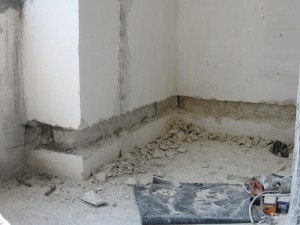
Pipe laying steps
The concealed pipe laying technique includes several stages, each of which is necessary:
- elaboration of the wiring diagram, clarification of all circumstances and creation of a plan;
- chasing under pipes;
- cleaning and strengthening the created channel;
- laying and installation of pipes;
- fixing the knees inside the channel with plastic clamps;
- connection of inputs and outputs of the system;
- test start-up of communication and tightness control;
- masking the cavity and creating viewing holes;
- decorative wall decoration
Technique and tool
When deciding how to ditch a wall under a pipe, it is necessary to find out the characteristics: material, density, composition of mixtures. Shredding is performed:
- manually with a hammer and chisel;
- grinder;
- impact drill or hammer drill;
- special chisel.
The first method is the most time-consuming, it is only suitable for fairly soft walls that do not contain reinforcing inserts. Chasing dense concrete by hand will take a lot of time and effort. The advantage of technology in the accuracy of work.
The work of an angle grinder is complicated by the need to control the pressure on the tool: it is problematic to make a single depth throughout the entire segment of the work. Detailed refinement and alignment are carried out with a chisel. The grinder reduces the time spent on creating the main track and gives a fairly even cutting line of the material.
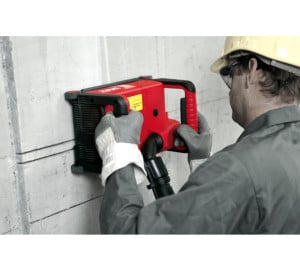
Dots are punched in the material with a drill or perforator. The distance between them should be 1-2 cm. Then the recesses are deepened and combined with a spatula-shaped nozzle.
The wall chaser is a professional tool designed specifically for this type of work. Only he can provide a channel that is even in depth and shape, facilitating the efforts of the master as much as possible. Lines are cut with a wall chaser, then the middle of the cavity is selected. The quality of work wins in comparison with other techniques.
A professional wall chaser, which can be rented if there is no need to purchase, is equipped with a special vacuum cleaner. The use of a petal mask does not preclude this. Chasing under pipes is a dusty job. It is worth covering not only all objects in the room where work is being done, but also upholstered furniture in neighboring rooms with a film preventing damage to surfaces.
Video: wall chasing rules
Shtroblenie walls for water supply refers to the overhaul of the premises. Using a professional tool will significantly reduce the duration of work and the likelihood of critical errors when laying communications. A preliminary consultation with a specialist will simplify the task and save time.
Add a comment
Features of polypropylene pipes
To mount the pipeline, high-quality and reliable material is required. It can be, for example, stainless or galvanized steel. Over time, polypropylene displaced these types from the construction industry. The main reason was the combination of useful properties at a reasonable price.
Polypropylene is suitable for hot and cold water supply, heating. The material is durable and does not require maintenance, so you can fearlessly immure water pipes into the wall.
The main thing is that their use does not exceed the temperature limit of 95 ° C, when the material loses pressure resistance and deforms. In water pipes and residential heating systems, such pipelines operate at lower temperatures of the working environment, so no problems should arise.
The disadvantage of the material is thermal expansion, which can directly affect the integrity of the wall into which the pipes are immured. The expansion coefficient of polypropylene is quite high. The linear increase can be up to 10 mm per meter of pipe at a temperature of 70 °C, respectively, the pipe diameter also increases slightly.
The higher the temperature, the more the coefficient of expansion of the pipe increases. Therefore, the laying of heating networks, their correct installation, and the choice of types of pipes corresponding to the conditions deserve special attention.
Installation requirements
When laying a pipe in a wall, it is recommended to use shock-absorbing materials. For example, energy flex, polyurethane foam. These materials will serve as a gap between the wall and the pipe, respectively, there will be no pressure on the concrete when the pipe expands.
The fewer connections, the better. Joints are the most vulnerable part of polypropylene systems, least protected from leaks and having low pressure resistance.
Pipes must be selected in accordance with the conditions of further operation.
According to the wall thickness, all PPR pipes are divided into categories from PN10 to PN25.
- Pipes PN10 - thin-walled, designed for cold water supply or for underfloor heating and other non-high-temperature systems with low pressure.
- PN16 and PN20 are used for water supply with pressure up to 1.5 MPa and heating systems with pressure not exceeding 0.8 MPa.
- PN25 is reinforced with a layer of fiberglass or aluminum, which increases strength and temperature range. Accordingly, the products can be used in central heating systems at pressures up to 1.5 MPa, and in cold water supply up to 2.5 MPa.
Basic requirements for covert communications
Building codes and regulations, which include the regulatory document SNiP 2.04.01-85, regulate the rules for the location of water pipes in the walls - it is useful to know them when carrying out installation work. The documentary acts indicate the following basic standards for the installation of water lines in the walls:
- Chasing of load-bearing walls is prohibited, as this reduces their strength and, accordingly, leads to a decrease in the stability of the entire structure.
- It is allowed to lay only one-piece structures connected by soldering or welding in the walls. If the connection is collapsible, provide access to it by installing inspection hatches or removable panels.
- When laying a pipeline from metal-plastic or metal elements, the placement of electrical wiring should be taken into account; during the gating, the electrical line at the work site must be de-energized.
- The gate should be laid taking into account the expansion of the pipeline material during heating, its depth and width are calculated for the maximum increase in the diameter of the passing pipes. It is recommended to install a compensation decoupling for every 3 linear meters of pipes carrying hot water.
Rice. 2 An example of chasing with a perforator
- Pipes are fastened with clamps; during installation, the pipeline should not come into contact with the walls of the channel - this contributes to the appearance of extraneous sounds during operation.
- The hot water pipeline placed inside the walls is recommended to be placed in a heat insulator (Energoflex) to reduce heat loss in the line.
- When sealing the strobe, the material should not be strongly compacted; it is advisable to leave air cavities in the case of linear expansion of the pipes.
Is it possible to hide polypropylene pipes in the wall
Self-installation of plumbing and heating systems is no longer a rarity: with the advent of affordable and inexpensive materials that do not require equipment for cutting and joining, many craftsmen undertake such work without fear.
Numerous master classes and video tutorials are ready to demonstrate all the stages from scratch to launching the system into operation.
And yet, some moments sometimes remain outside the frame: the question of whether polypropylene pipes can be hidden in the wall in order to effectively complete the decorative finish often remains open.
Hidden heating system
Modern technologies allow to improve the aesthetic appearance of the room in various ways. The method of placing heating pipes in the room was no exception.
It becomes possible to place them in the wall, thanks to the durability of the material used in their production.
Advantages and disadvantages
It is most convenient to place communications in the wall at the construction stage in a private house according to a previously created drawing. You can hide pipes in the wall in an apartment building if you plan to overhaul the premises, or the entire building.
By placing the heating in the wall, of course, the room looks more prestigious, and the vacated space can be decorated.
Pros:
- heat transfer increases, since building materials have an increased level of heat transfer, unlike air;
- the service life of polypropylene, from which the pipes are made, reaches up to 50 years, ensuring the reliability of the structure, subject to technical standards during their installation;
- increases the space by several centimeters.
However, it is necessary to overcome the difficulties that lie in obtaining the right to permit a change in the position of communications in the room or the so-called redevelopment.
Minuses:
- low-quality propylene increases in volume when heated;
- ordering a project to change the location of communications;
- coordination of the project with supervisory authorities. Alteration of engineering systems in an apartment building will require a special permit;
- joints may lose sealing, which can only be determined using a device that measures water pressure;
- risks associated with the readiness to destroy the wall in case of a possible leak.
A break in the pipes of the heating system in the wall in the event of a leak will cause water to enter the neighboring lower apartment, since it will not be possible to quickly eliminate the leak.
How to wall up heating pipes in a wall
To disguise the pipes of the heating system into the wall, it is necessary to find out what material the wall consists of, and select the method and sequence of work, as well as the necessary materials.
Before laying heating pipes, it is necessary to test them for strength, visually carefully check for possible damage.
Concrete
In the apartment of a panel apartment building, there are two ways of laying pipes of the heating system: using strobes - specially created channels for laying heating pipes in them or creating a false wall.
How to remove heating into a wall in a panel house step by step using a strobe:
- you need to start by de-energizing the common house heating riser. You should make sure that the desired riser is turned off;
- strobes should not be located back to back. It is impossible to allow infringement of the contour.The recess is calculated based on the parameters of the fasteners, their number and the layer of prepared insulation;
- directly covering the heating pipes with an insulating layer. Insulation is applied to prevent condensation;
- then calculate the places for fastening and mark the location of the fasteners.
The work is done by a Bulgarian. It allows you to perform high-quality actions in automatic mode and facilitates wall chasing.
When erecting a false wall, it should be borne in mind that the space of the room will decrease.
Brick
Strobels are punched in a brick wall in the same way as in a panel wall.
The procedure for laying part of the heating system in a brick wall:
- the depth or width of the channel is determined taking into account the amount of winding of insulation on the surface of the pipe;
- after which they are placed in the marked places and fixed with clamps, pre-fixed with self-tapping screws.
It is necessary to test the system by running water at excess pressure for several days. After making sure that there are no leaks, the wall with communications is covered with mortar and puttied.
How to hide or disguise pipes
In any apartment there are, if not heating pipes, then plumbing for sure. Twenty years ago, the only solution to make them not conspicuous was to paint the walls in the color of the walls, and with oil paint (or enamel). And the pipes were almost all metal.
Today, almost all metal-plastic pipes are used, neat and light. But what to do if even the whites do not want to be left in sight? Of course hide!
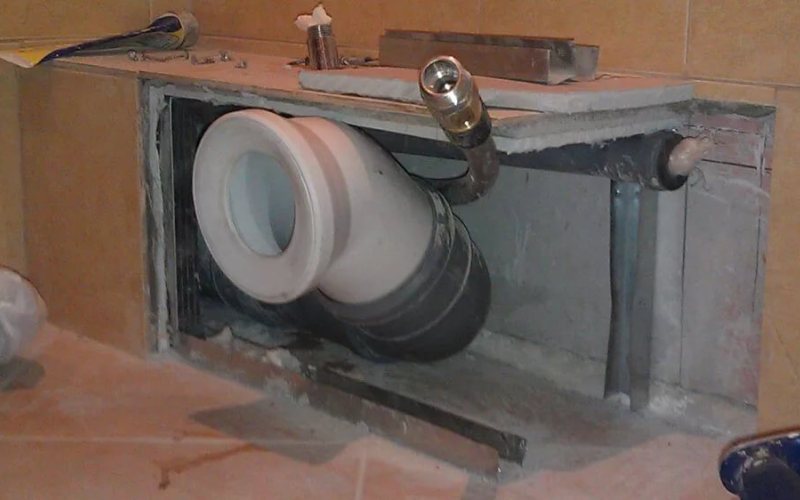
A strobe in the wall will help hide the water pipes, but this method brings some problems with a possible water leak. Especially if you live in an old-style apartment building. Although from the point of view of aesthetics, the closed installation method is more correct.
Sewer pipes in modern houses are hidden in a shaft, which is covered with finishing materials. But still, experts recommend leaving the hatch, which, in which case, you can open and check the condition of the pipes.
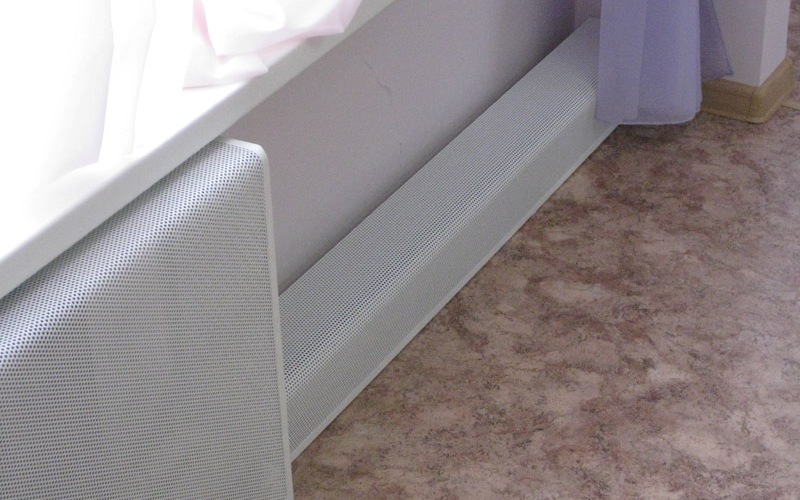
In order not to create problems for yourself in the future, water pipes can be hidden in a box, for example, plastic. Well, if you want to do everything more efficiently, then you can make a similar camouflage box with your own hands. for example, from a profile and plywood, and then paint in the color of the walls or furniture.
Similarly, you can also hide the heating pipes, which, as a rule, stretch through all the floors of an apartment building. They can even be hidden in a cabinet or behind decorative panels.
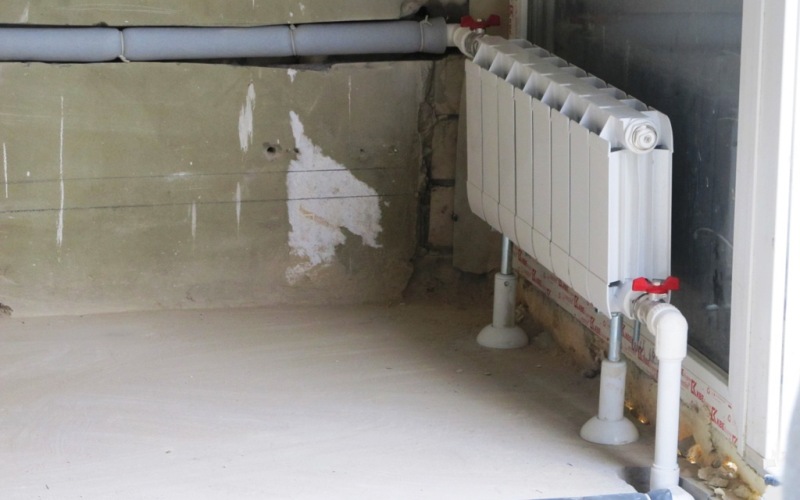
But it is strictly forbidden to do this with gas pipes. In the event of a gas leak, the pipes must be instantly accessible, so the only way to disguise them is to hide them in a locker.
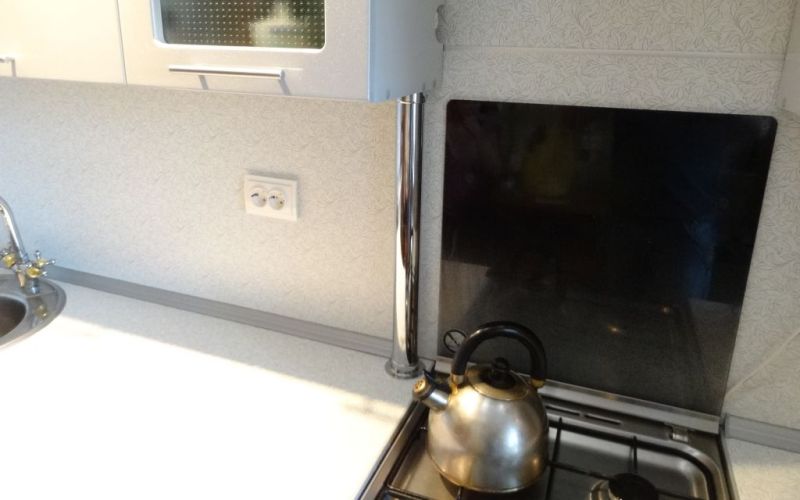
Homemade wall chaser
A professional wall chaser is an expensive tool that, according to the principle of operation and design, is practically no different from a grinder. This allows craftsmen to make some changes to the design of the elements of the angle grinder to effectively perform the functions of gating.
Two disks. Installing two disks allows you to speed up the work and improve their quality - the channel is cut in one pass, and its width is the same along the entire length. If the strobe is narrow, the alteration is quite simple - a second disk is placed on the grinder, the width of the strobe is set by a washer installed between the disks. To increase the distance between the cutting wheels, you can make a nozzle on the grinder with a wider seat on a lathe.

Fig. 9 How to make furrows for water supply pipelines with a grinder without dust
Nozzle for the vacuum cleaner.To combat dust, some craftsmen make a separate nozzle for a grinder with a fitting in order to connect a vacuum cleaner. To realize this improvement, soldering or welding, which is rather difficult for a non-specialist, is required.
There is an easier way to deal with dust - a piece of a water pipe is tied to the handle of an angle grinder with masking tape and a vacuum cleaner is connected to it.
Chasing concrete walls in panel houses with a grinder
With the help of a grinder, a strobe with neat, even edges is obtained - this facilitates the further placement of the pipeline in the channel, and besides, its use significantly increases the speed of the work being done. The gating procedure using a grinder consists of the following steps:
- They install a diamond-coated disc on concrete on the grinder and cut the wall strictly along the line to the desired depth, not forgetting to use protective equipment against dust during operation.
- A perforator with a spade-shaped nozzle or a chisel with a hammer knocks out concrete between the cut grooves. During the work, the deepening of the strobe with a piece of pipe is controlled, trying to maintain a depth of at least 5 mm. from the plane of the wall.
- After carrying out the work, the channel is cleaned of dirt and dust accumulated in it with a brush, before sealing with a gypsum binder, the surface of the strobe is moistened.
Rice. 7 How to make strobes for pipes when using a perforator
Pros and cons of methods for hiding heating pipes
Drywall and laminate constructions
Many people choose such a method as hiding heating pipes in a new building with a laminate by building a box out of it. In this case, the design turns out to be designed like the floor. If, in addition to the heating pipes, there are other communications in the house, it is best to hide them with a false wall made of plasterboard.
The considered method has a number of disadvantages, for example:
- not suitable for metal-plastic and polypropylene pipes. which are connected by collapsible fittings;
- if the pipe is old, it is very risky to put the pipe into the box: a leak that has occurred can bring a lot of trouble;
- before hiding stainless, copper and steel pipes behind a decorative box, it is better to cover them with heat-insulating material;
- false wall equipment reduces the space of the room.
But, formed as a result of the construction of a false wall, a niche can be used to advantage. For example, by laying a layer of insulation, you can improve the light and sound insulation quite well. You can use such a place for a night light or place a stereo system. Using a niche to good use, false wall equipment will be a completely justified option for hiding pipes for heating.
Hiding lines in the wall, floor
This method, how to hide heating pipes in a floor screed or in a wall, is not suitable for all highways.
They have heating pipes in the wall, pluses and minuses that you need to know before choosing this method of masking the line. The main advantage of the method is that the design of the room will not be disturbed and overloaded with additional details. True, there are also disadvantages. For example, the complexity of installation. If the pipe leaks, you will have to destroy the wall for repairs.
For a private house - this is a very practical option.
The use of decor elements
Decorative rosettes for heating pipes are a great option for hiding pipes.
Thus, today there are many ways to hide heating pipes in a private house. It is advisable to close the highways at the stage of construction of the building. But even after construction, pipes can be decorated. Each of the methods has its own advantages and disadvantages. And which one to give preference to depends on the type of pipeline, operating conditions and the chosen design of the room.
